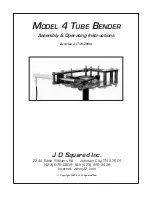
Appendix B: Algorithms
TLS 216 User Manual
B–3
Hysteresis
is a band comprising 10% of the waveform amplitude. It is used in
MCross1
,
MCross2
, and
MCross3
calculations.
For example, once a crossing has been measured in a negative direction, the
waveform data must fall below 10% of the amplitude from the
MidRef
point
before the measurement system is armed and ready for a positive crossing.
Similarly, after a positive
MidRef
crossing, waveform data must go above 10%
of the amplitude before a negative crossing can be measured. Hysteresis is useful
when you are measuring noisy signals, because it allows the logic scope to
ignore minor fluctuations in the signal.
MCross1, MCross2, and MCross3
refer to the first, second, and third
MidRef
cross
times, respectively. See Figure B–1.
The polarity of the crossings does not matter for these variables, but the
crossings alternate in polarity; that is,
MCross1
could be a positive or negative
crossing, but if
MCross1
is a positive crossing,
MCross2
will be a negative
crossing.
The logic scope calculates these values as follows:
1. Find the first
MidRefCrossing
in the waveform record or the gated region.
This is
MCross1
.
2. Continuing from
MCross1
, find the next
MidRefCrossing
in the waveform
record (or the gated region) of the opposite polarity of
MCross1
. This is
MCross2
.
3. Continuing from
MCross2
, find the next
MidRefCrossing
in the waveform
record (or the gated region of the same polarity as
MCross1
. This is
MCross3
.
MCross1Polarity
is the polarity of first crossing (no default). It can be rising or
falling.
StartCycle
is the starting time for cycle measurements. It is a floating-point
number with values between 0.0 and (
RecordLength
– 1.0), inclusive.
StartCycle
=
MCross1
EndCycle
is the ending time for cycle measurements. It is a floating-point
number with values between 0.0 and (
RecordLength
– 1.0), inclusive.
EndCycle
=
MCross3
MCross Calculations
Summary of Contents for P6240
Page 5: ......
Page 7: ......
Page 15: ...Table of Contents viii TLS 216 User Manual...
Page 20: ...Getting Started...
Page 26: ...Start Up 1 6 TLS 216 User Manual...
Page 51: ...Operating Basics...
Page 53: ...Overview 2 2 TLS 216 User Manual...
Page 73: ...Acquisition 2 22 TLS 216 User Manual...
Page 82: ...Reference...
Page 94: ...Adjusting the Vertical Setup 3 12 TLS 216 User Manual...
Page 104: ...Choosing an Acquisition Mode 3 22 TLS 216 User Manual...
Page 112: ...Choosing a Group Display Mode 3 30 TLS 216 User Manual...
Page 122: ...Customizing the Display 3 40 TLS 216 User Manual...
Page 130: ...Customizing the Display Colors 3 48 TLS 216 User Manual...
Page 162: ...Measuring Waveforms Automatically 3 80 TLS 216 User Manual...
Page 168: ...Measuring Waveforms with Cursors 3 86 TLS 216 User Manual...
Page 178: ...Printing a Hardcopy 3 96 TLS 216 User Manual...
Page 186: ...Probing of Circuits 3 104 TLS 216 User Manual...
Page 198: ...Saving and Recalling Waveforms 3 116 TLS 216 User Manual...
Page 222: ...Triggering on Patterns 3 140 TLS 216 User Manual...
Page 252: ...Triggering on States 3 170 TLS 216 User Manual...
Page 256: ...Viewing Status 3 174 TLS 216 User Manual...
Page 261: ...Appendices...
Page 283: ...Appendix B Algorithms B 18 TLS 216 User Manual...
Page 285: ...Appendix C Packaging for Shipment C 2 TLS 216 User Manual...
Page 290: ...Glossary...
Page 302: ...Glossary Glossary 12 TLS 216 User Manual...
Page 303: ...Index...
Page 319: ...Index Index 16 TLS 216 User Manual...
Page 320: ......
Page 321: ......
















































